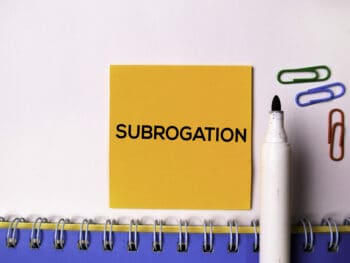Several adjusters are quick to rule out subrogation during the investigation phase of their files, especially when the issue or injury is due to “Human error” and not necessarily due to a third party.
I see this as incentive to get creative. Taking a step back to see what exactly happened and how this worker became injured is the fun part of solving the claims subrogation mystery.
The Case of The Hidden $900,000 Recovery
For example, I read about a case where a worker had a large square container on a crane. His supervisor told him to ride on top of the container to get to a higher level instead of going out to get the lift truck. For whatever reason, this worker agreed. The container was clearly marked that riding on it is dangerous and can result in injury. The crane was marked with numerous labels saying not to lift people on items, and so on. Plus, the supervisor told the employee to ride on the container.
Based on all of that, it should seem clear that there is no subro on this case. This worker obeyed a command from his direct supervisor. The supervisor was the one that made the error in judgement. This worker riding the container fell off of it and sustained a traumatic brain injury.
Most carriers would give up at this point, as it is clear the subro case is probably not existent. However, this carrier discussed the case with Counsel and subrogation experts, and they saw an angle about how to pursue premises subrogation on the carrier that had the risk where the construction job was located. Months later, the subro case was settled to the tune of a $900,000 recovery.
Adjusters as a whole are bombarded with information. They are in charge of costs, contacts, claims, medical, vendors, legal aspects, meetings, phone calls, emails, you name it. They are sometimes stuck in a rut of compensable claim investigations, boring investigations, and worrying about pointless metrics on indemnity claims.
Take A Step Back And Think About Possibilities
The subro case above is the type of case where the job is interesting, and challenges you to take a step back and think about possibilities.
Even in a situation as clear as this where on the surface a supervisor commanded a worker to ride a container, subrogation and recovery possibilities can lie dormant in plenty of claims. If you find an angle to do subro on a case where someone else ruled it out as impossible, you are going to look like a champ in your office.
The challenge is to find the time to look at it with a different set of eyes. This is not to say that you are going to take every file and start firing off subro notice letters on all of them, but I suspect plenty are out there where a subro letter may yield some results of recovery.
Case #2 Example of Subrogation Potential
Case #2 to prove my point, a worker fell off of a rented hi-lo. He slipped off when his boot slipped on a step. This was an old hi-lo, it had no grab bars, no cage, and no anti-slip materials on the floor of it. When placed on notice, the rental company resisted settlement. The carrier then added in the manufacturer of the hi-lo, because the enclosed step was a hazard itself.
The step posed a risk because of work boots. Even the person with the smallest foot could never fit their foot in the step because the step is not big enough. It is made for people that wear tennis shows, and not steel-toed boots.
This case is still going on, but I suspect they may have an angle on that case for a recovery of some sort. The rental company failed to maintain the hi-lo with anti-slip surface on the floor, and the makers of the hi-lo had a poor design with the “step” that was put in to help workers. The step itself actually made the hi-lo more dangerous. Plus no grab bars, no cage, etc.
So you see you can try to push subro on anything. The worst that can happen is that the other carrier will tell you no. Keep pushing those cases in to the pipeline, and you will land a trophy recovery sooner or later.
Author Michael B. Stack, Principal, COMPClub, Amaxx Work Comp Solutions. He is an expert in employer communication systems and helps employers reduce their workers comp costs by 20% to 50%. He resides in the Boston area and works as a Qualified Loss Management Program provider working with high experience modification factor companies in the Massachusetts State Risk Pool. He is co-author of the #1 selling book on cost containment, Your Ultimate Guide To Mastering Workers Comp Costs www.reduceyourworkerscomp.com, and Founder of the interactive Workers’ Comp Training platform COMPClub. Contact: mstack@reduceyourworkerscomp.com.
©2015 Amaxx LLC. All rights reserved under International Copyright Law.
SALES TO PAY FOR ACCIDENTS CALCULATOR: http://reduceyourworkerscomp.com/sales-to-pay-for-accidents-calculator/
MODIFIED DUTY CALCULATOR: http://reduceyourworkerscomp.com/transitional-duty-cost-calculators/
WC GROUP: http://www.linkedin.com/groups?homeNewMember=&gid=1922050/
SUBSCRIBE: Workers Comp Resource Center Newsletter
WORKERS’ COMP TRAINING: https://workerscompclub.com
Do not use this information without independent verification. All state laws vary. You should consult with your insurance broker, attorney, or qualified professional.






